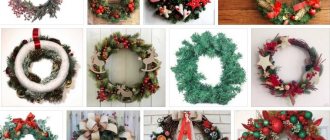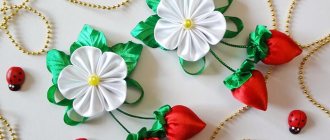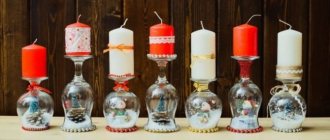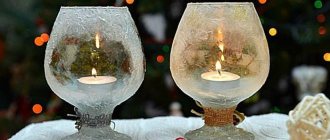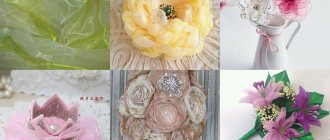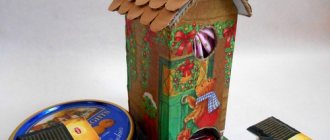Rate this post
Hi all!
On Victory Day, everyone around rejoices, laughs, remembers their loved ones who died in the war and pays tribute to them to the memory of a grateful generation. And of course, on this day a solemn atmosphere reigns everywhere.
One of the permanent attributes of the May 9 holiday is the St. George Ribbon. It is tied on arms, pinned to clothes, backpacks, depicted in posters... But why not add a little variety to the generally accepted traditions and make this symbol even more elegant?
I have put together master classes for you showing how you can make beautiful brooches or jewelry from an ordinary St. George’s ribbon in different ways. The techniques presented in this article range from the simplest to more complex ones that children will find difficult to implement without adult help. Remember that, among other things, you can make other crafts in this topic.
Therefore, all ideas are great for family creativity and will not only be an excellent way to show your attention on May 9, but will also give you an opportunity to once again spend time with your closest people.
DIY New Year's garlands for a paper Christmas tree: diagram, template
- The simplest garland that even a child can handle is a chain of paper rings . To make it you will need multi-colored paper (3-4 colors or with a pattern), scissors, and glue.
- Cut the paper into thin strips (1-1.5 cm wide and 8-12 cm long). You can use a figured hole punch to create “lace” rings.
- Roll the first strip into a ring and glue it together. Glue all subsequent strips into a ring, threading them into the previous one.
- You can decorate a Christmas tree or room with such a garland, and you can also use this idea not only for the New Year, but also to create a festive mood on any other special day.
Garland of rings
For a chain of links you will only need a pencil, scissors and colored paper.
- Trace the half garland link template onto construction paper or cardboard and cut it out.
- Cut the colored paper into appropriately sized squares or rectangles and fold each in half.
- Place the template along the fold side, trace and cut out - there should be quite a lot of links.
- Assemble the chain by threading each subsequent link into the previous one.
Garland made of paper links
A garland made of paper strips looks very elegant.
- Cut strips of thick colored paper 2-2.5 cm wide.
- Arrange all the elements on the table in the correct order by color.
- Sew the strips down the center, leaving a small space between them - do this by hand or use a sewing machine.
Garland of stripes
- As elements you can use not only stripes, but also circles, stars, flags, hearts, men or other shapes of various sizes.
- It is better to hang such a decoration vertically, adding a weighting agent (a large bead, button or a piece of colored plasticine) at the bottom of the garland.
DIY garland of circles and beads
Advent calendars, popular in European countries, bring a lot of joy to children in anticipation of Christmas and New Year. The meaning of such calendars lies in small daily surprises (sweets, small toys, stationery), which are hidden in bags, boxes or windows.
You can make a similar calendar for your children in the form of a garland, which will be both a decoration for the children’s room and a symbol of the approaching miracle.
- Take 31 matchboxes (you can use homemade paper boxes).
- Put a little surprise in each box - all mothers know perfectly well what will please the baby.
- Wrap each box in multi-colored corrugated paper, tie it with a ribbon, glue a circle with a number from 1 to 31 and connect it into one garland.
Garland calendar
- Together with the boxes, you can use small bags in the form of Santa caps, mittens or socks. Such a garland looks simply fabulous, as if the heroes of New Year’s magic hung their clothes on a rope to dry.
- Don’t forget to prepare this garland in advance and start opening surprises on December 1st - then every day of the month will bring new joy to your child.
Garland of socks and mittens
For a snake garland you will need corrugated paper, which must be cut into long strips 5-6 cm wide.
- Glue the strips together by connecting the corners perpendicular to each other.
- Fold each strip alternately, one on top of the other.
- Glue the ends of the strips and straighten the garland.
Snake garland
Together with an older child, you can make a more complex volumetric paper decoration .
- Using one of the templates, cut out the garland elements (3-4 pieces for each fragment) from colored or white paper.
- Glue all the elements together using double-sided tape or cut one from the top to the middle, and the other from the bottom and insert one into the other.
- You can hang these decorations one at a time or combine them into a large garland.
“Herringbone” cutting template “Snowman” cutting template “Bells” cutting template
History of sewing accessories. Part 1: measuring tape
You can admire almost endlessly vintage and antique craft tools.
Yes, this decor is non-functional in most cases, but how nice it is to pick up a beautiful thing, made gracefully and reliably. There are many sewing devices, accessories and tools, and almost all of them go back thousands of years. But some of them are quite young. Today I propose to take a closer look at the tailor's meter.
Some kind of measuring tape in the form of narrow strips of leather was known back in Ancient Rome. But in its usual form, a measuring tape is a relatively young invention. According to some sources, it was invented by a French tailor in 1810; according to others, the measuring tape was invented by Alexis Lavigne in 1847. The British also point to their inventors of the measuring tape. Documents have been preserved indicating that in 1838 a young Englishman, Charles White, brought to Australia a “measuring tape”, stored in a metal case and removed using a wooden ring at the end of the tape.
Probably Charles White's tape could have looked something like this, 1820.
In South London, from the 1830s, there was the firm of Edward Dean producing tailor's measuring tapes and folding meters.
They also began to produce measuring tapes made of flexible steel. In museums, on the websites of collectors and antique dealers, you can find examples of measuring tapes dating from 1800-1830. Therefore, when we talk about the invention of a centimeter tape or obtaining a patent for it, we can rather talk about the features of manufacturing or storing a centimeter, special materials, widespread introduction to the masses or industrial production. Why centimeters were produced mainly in a case - everything is simple here. This is a textile tape, sometimes silk, with marks applied in ink, in some cases by hand, and of course a case with a return mechanism ensured greater safety. But what explains such a surge of interest in the middle of the 19th century? Let's try to figure it out. But for this we will have to take a short excursion into the history of costume and fashion.
In the Ancient World, in Medieval Europe, as well as in traditional cultures, clothing was cut extremely simply and economically. The main parameters are the dimensions of the human body (which are easier to measure with improvised means) and the width of the homespun fabric. For centuries, and sometimes even millennia, the same types of clothing have been preserved. The Japanese kimono is one of the most striking examples, but you can also recall the Roman toga and tunic, which existed from the rise of Rome until the collapse of the Empire, the ancient Egyptian costume, which retained its shape for thousands of years, and many other examples. Changes most often had a superficial, decorative nature that did not affect the internal structure of the costume, and new forms of clothing appeared extremely rarely. Changes were often explained by external influences - the preferences of rulers, conquest or trade relations. For a long time, these changes did not add up to the fashion system. But in the 14th century, a new type of costume appeared in Western Europe, fundamentally different for men and women. The men's suit became narrow, short, and tight-fitting. The women's suit remained long, falling to the floor. But this was no longer a medieval robe that hid the body, but an elegant dress that emphasized the figure. From this time on, changes in costume became the rule of existence in society. People begin to pay attention to the realm of the ephemeral, analyze the changes taking place in the field of costume, begin to become interested in various traditions and customs associated with costume and fashion, and decisions in the field of appearance become more and more daring. But the main thing is that the value of traditions and the heritage of ancestors is rejected, and novelty and modernity are extolled. Fashion is ridiculed and condemned, but it is also imitated. But appearing old-fashioned is becoming unprestigious.
For a long time, fashion related only to the clothing of the nobility. Dress followed the social hierarchy and violations were severely punished. However, by the 19th century, fashion was finally formed as a system and social institution known to us. Fashion reaches all levels of society and, due to the growth of ready-made clothing, is becoming accessible to all. The French Revolution and subsequent social upheavals shake up the strict hierarchy. In the same way, outdated guild craft rules are becoming a thing of the past. By the end of the 18th century, tailors, seamstresses, and milliners were winning the right to some independence. Previously, they were only anonymous creators, embodiments of other people's ideas. From the history of costume, we know the names of aristocrats and celebrities who introduced these new items into fashion, but the name of Rose Bertin is already known to fashion connoisseurs along with the name of Marie Antoinette. But in the 19th century, the role of the fashion designer, tailor, and milliner increased even more. They become creators, creating new shapes and lines. And this is where we remember again about Alexis Lavin. He was not only an outstanding tailor, but also an inventor. In 1841, he opened the first School of Fashion, in 1847 he invented a soft measuring tape, and in 1849 he introduced a bust-mannequin for fitting, developed a cutting system, as well as summary tables of sizes. It is thanks to such improvements that the Guerre-Lavine Fashion School has gained worldwide fame.
If earlier tailors strictly kept their craft secrets secret, and knowledge about creating fashionable clothes was passed on mainly through experience, then in the 19th century this knowledge became publicly available. The number of fashion magazines is growing, various cutting and sewing manuals are published, the first paper patterns appear, and magazines publish instructions on how to make this or that model at home. Fabrics and haberdashery goods become more varied and accessible, and fashion and its innovations become widely known and desired. An elegant, beautifully packaged centimeter turns into a symbol of the profession of fashion designer and tailor, and turns out to be an indispensable assistant for both professional seamstresses and amateurs.
DIY Christmas garlands for windows made of paper: ideas, templates, photos
A light garland of multi-colored lanterns is a wonderful decoration for windows. This design creates a magical atmosphere at home and looks elegant from the outside.
- Prepare an electric garland - check it in advance to eliminate defects.
- Take strips of colored paper measuring 10x25 cm - you will need several strips according to the number of light bulbs in the garland.
- Using a ruler and pencil, line each piece into strips 1-1.5 cm wide.
- Repeat the same action using a sharp object - a thin awl or needle. After this, the flashlight blank will be easy to bend in the designated areas.
- Gather the paper into an accordion along the folds, then straighten and join in the shape of a cylinder using PVA glue.
- Carefully pull the top and bottom edges together and secure them to the garland using a needle and thread.
Flags in the form of a garland for decorating a room, printable templates
Now I present to your attention a long-forgotten idea in the form of flags. After all, this is the most common way to decorate a Christmas tree or rooms. You can also decorate doorways or windows with them.
You will need:
- textile
- stencils
- threads
- rope
Print the templates on a piece of paper or draw them yourself, attach them to the fabric and cut out the desired image.
Sew all the blanks onto a strip of fabric or rope. And then iron the flags.
You can also use felt, since it does not crumble and it will be easy for you to complete this craft.
Or also make a garland out of cardboard or paper.
Take the templates and print them out:
Then apply glue, place a string and glue the two halves together.
Take the next masterpiece to your collection.
I also really like this job. Bravo to the master!
Video: DIY New Year's Toys. How to Make Christmas Balls From Paper. DIY Christmas Balls
You can decorate not only the Christmas tree with New Year's balls, but also hang them on the windows, connecting them into a garland.
DIY window decorations
- Take ribbons that match the color and hang balls or other decorations (natural cones, slices of dried fruit, beads) at different heights across the entire width of the window.
- Decoration with branches will appeal to lovers of all things natural. Collect fallen branches, for example from a park, or buy several fir branches and secure them with fishing line or wire in the middle of the window.
Garlands on a branch
You can hang any decor on such a branch - Christmas tree decorations, paper snowflakes, wooden pendants, tinsel, pine cones.
Figures cut out from orange or lemon zest using a cookie cutter look bright and elegant.
Orange zest garland
Another option for decorating a window would be a New Year's wreath .
- Take a large sheet of thick cardboard. If there is no suitable size, you can cut off part of the cardboard box.
- Cut out the wreath blank in the shape of a ring.
- Attach fir branches, cones to the ring, decorate with tinsel, decorative beads, small balls or ribbons.
New Year's wreaths for decorating windows and doors
History of sewing accessories. Part 1: measuring tape
You can admire almost endlessly vintage and antique craft tools. Yes, this decor is non-functional in most cases, but how nice it is to pick up a beautiful thing, made gracefully and reliably.
There are many sewing devices, accessories and tools, and almost all of them go back thousands of years. But some of them are quite young. Today I propose to take a closer look at the tailor's meter.
Some kind of measuring tape in the form of narrow strips of leather was known back in Ancient Rome. But in its usual form, a measuring tape is a relatively young invention. According to some sources, it was invented by a French tailor in 1810; according to others, the measuring tape was invented by Alexis Lavigne in 1847. The British also point to their inventors of the measuring tape. Documents have been preserved indicating that in 1838 a young Englishman, Charles White, brought to Australia a “measuring tape”, stored in a metal case and removed using a wooden ring at the end of the tape.
Probably Charles White's tape could have looked something like this, 1820.
In South London, from the 1830s, there was the firm of Edward Dean producing tailor's measuring tapes and folding meters. In December 1864, William H. Bangs received a patent in the United States for a tailor's tape in a roulette wheel with a "return mechanism." In 1868 Alvin J. Fellow received a patent for a similar invention.
They also began to produce measuring tapes made of flexible steel. In museums, on the websites of collectors and antique dealers, you can find examples of measuring tapes dating from 1800-1830. Therefore, when we talk about the invention of a centimeter tape or obtaining a patent for it, we can rather talk about the features of manufacturing or storing a centimeter, special materials, widespread introduction to the masses or industrial production. Why centimeters were produced mainly in a case - everything is simple here. This is a textile tape, sometimes silk, with marks applied in ink, in some cases by hand, and of course a case with a return mechanism ensured greater safety. But what explains such a surge of interest in the middle of the 19th century? Let's try to figure it out. But for this we will have to take a short excursion into the history of costume and fashion.
In the Ancient World, in Medieval Europe, as well as in traditional cultures, clothing was cut extremely simply and economically. The main parameters are the dimensions of the human body (which are easier to measure with improvised means) and the width of the homespun fabric. For centuries, and sometimes even millennia, the same types of clothing have been preserved. The Japanese kimono is one of the most striking examples, but you can also recall the Roman toga and tunic, which existed from the rise of Rome until the collapse of the Empire, the ancient Egyptian costume, which retained its shape for thousands of years, and many other examples. Changes most often had a superficial, decorative nature that did not affect the internal structure of the costume, and new forms of clothing appeared extremely rarely. Changes were often explained by external influences - the preferences of rulers, conquest or trade relations. For a long time, these changes did not add up to the fashion system. But in the 14th century, a new type of costume appeared in Western Europe, fundamentally different for men and women. The men's suit became narrow, short, and tight-fitting. The women's suit remained long, falling to the floor. But this was no longer a medieval robe that hid the body, but an elegant dress that emphasized the figure. From this time on, changes in costume became the rule of existence in society. People begin to pay attention to the realm of the ephemeral, analyze the changes taking place in the field of costume, begin to become interested in various traditions and customs associated with costume and fashion, and decisions in the field of appearance become more and more daring. But the main thing is that the value of traditions and the heritage of ancestors is rejected, and novelty and modernity are extolled. Fashion is ridiculed and condemned, but it is also imitated. But appearing old-fashioned is becoming unprestigious.
For a long time, fashion related only to the clothing of the nobility. Dress followed the social hierarchy and violations were severely punished. However, by the 19th century, fashion was finally formed as a system and social institution known to us. Fashion reaches all levels of society and, due to the growth of ready-made clothing, is becoming accessible to all. The French Revolution and subsequent social upheavals shake up the strict hierarchy. In the same way, outdated guild craft rules are becoming a thing of the past. By the end of the 18th century, tailors, seamstresses, and milliners were winning the right to some independence. Previously, they were only anonymous creators, embodiments of other people's ideas. From the history of costume, we know the names of aristocrats and celebrities who introduced these new items into fashion, but the name of Rose Bertin is already known to fashion connoisseurs along with the name of Marie Antoinette. But in the 19th century, the role of the fashion designer, tailor, and milliner increased even more. They become creators, creating new shapes and lines. And this is where we remember again about Alexis Lavin. He was not only an outstanding tailor, but also an inventor. In 1841, he opened the first School of Fashion, in 1847 he invented a soft measuring tape, and in 1849 he introduced a bust-mannequin for fitting, developed a cutting system, as well as summary tables of sizes. It is thanks to such improvements that the Guerre-Lavine Fashion School has gained worldwide fame.
DIY Christmas garland on the wall made from figurines
Please your children with a bright and festive garland of cute fairy-tale characters.
- Cut out all the elements of the garland according to the template from white paper.
- If desired, decorate the figures or make appliqués together with your child, adding individuality to each element.
- Connect all the fragments and decorate the walls in a children's room or living room with a cheerful garland.
Template for a garland of figurines
You can sew figurines for a garland from felt, cut from wood or knit from yarn.
DIY garland of figurines
The original garland will be made from cookies in the shape of New Year's symbols.
Cookie Garland
Areas of use
It is customary to highlight several areas of use for crafts made from ribbons. You can create such beautiful things together with your child.
According to pediatricians, children who do handicrafts have a higher level of development and activity. This is explained by the fact that when creating a certain craft, it is necessary to complete quite a few related tasks.
It turns out that when you teach a child to sew, you teach him to make decisions on his own. In addition, needlework develops fine motor skills, as well as accuracy, patience, attentiveness and perseverance. By making accessories from ribbons, children learn how to use a needle, and this skill will definitely be useful to them in later life.
Speaking of adults, fake ribbons can be used to decorate not only clothes, but also interiors for the holiday. This will not require significant financial expenditure, but such things always look original and stylish.
In addition, accessories made from satin ribbons can serve as a wonderful gift for family and friends.
DIY Christmas garland for the fireplace made from fir branches
If you have a fireplace in your home, decorating it is important because the hearth symbol is the main focal point.
- For decoration, the mantelpiece, the space above the fireplace and on the sides of the firebox are used.
- You can place a wreath of fir branches and cones above the fireplace, attach several fir branches along the mantelpiece in the form of a garland (this can be done using thin wire) and decorate with tinsel, bows and hanging balls.
- Hang a few Christmas stockings here, and on New Year's Eve fill them with sweets and little surprises for children and adults.
Fireplace decorations
DIY Christmas garland on the ceiling made from balls
A bright garland can be made by connecting multi-colored pom-pom balls made of thread, paper or cotton wool with a ribbon.
To make a garland of pompoms, you will need wool threads of several colors. You can use a variety of leftover yarn.
- Cut out two identical rings from thick paper of the same diameter as the pompom you want to end up with.
- Connect both rings together and wrap tightly with thread. Cut the threads along the outer contour of the rings.
- Pass the end of the thread between the paper rings, pull the pompom tightly and tie.
- The rings can now be removed and used for the next pompom.
- When all the pompoms are ready, connect them using fishing line or satin ribbon. The elements of the garland can consist of different threads and vary in size.
Garlands of pompoms
Fluffy, cheerful pompoms can be made from paper.
Necessary materials
The name and quantity of the material depends on what type of paper garland will be made and in what volume. There are simplified options with minimal costs of material and time, and there are more complex ones that also require intelligence and skills.
The most commonly used materials are:
- sweet wrappers;
- congratulatory letters, cards;
- pages of colorful magazines;
- colored paper (usually double-sided);
- cardboard (white, colored single-sided, double-sided);
- foil, corrugated paper;
- foamiran;
- regular, curly scissors;
- glue, stapler, double-sided and regular tape;
- satin ribbon, thread, rope;
- beads, sequins, buttons, etc.
It often happens that during preparation, new ideas for craftsmanship come and you have to resort to additional preparation of the material.
We recommend videos on the topic:
Video: Making pompoms from corrugated paper and napkins
You can captivate your child for a long time by inviting him to decorate white ping-pong balls. Here you can safely show your imagination - paste stickers, draw pictures, cover them with a pattern of sparkles or beads. The finished balls then need to be carefully pierced with a hot needle and strung on a fishing line or thin ribbon.
A simpler version of a garland for the New Year with your own hands can be made from cotton wool by collecting ready-made balls or disks on a string.
Garlands made of cotton wool
A very beautiful garland can be made from paper balls made using the origami technique. You will learn how to do this in the following video.
Garlands of pine cones and light bulbs
Already in one of the articles, when we were making souvenirs for the New Year, I showed how you can quickly and beautifully decorate pine cones. And here, too, you can use this product. Dip a pine or fir cone into PVA glue and then let it dry. This is the first option, you can use acrylic paints.
But the second one, dip it in PVA, and then in semolina or glitter. Let the natural material dry.
Then tie a red thread to the cone, after a couple of centimeters again and so on.
Alternatively, you can sprinkle artificial snow on PVA or regular salt.
In general, use your imagination and act!
Here's another idea using wire.
You can make a garland of light bulbs, dip each one in paint and let it dry upside down. Then tie it on tinsel. And voila, the shining multi-colored composition is ready.
How to make a New Year's garland from tinsel and Christmas tree decorations for the door?
To decorate your front door for the New Year holidays, you can make a garland of tinsel and Christmas tree decorations and hang it around the perimeter of the opening from the outside or inside.
- It is better to take an electric garland as a basis.
- Carefully wrap it with fluffy dark green tinsel that imitates spruce branches.
- Having secured the garland above the door, hang Christmas tree balls or other small toys on it at different heights, but so that they do not interfere with entering the room.
Door decoration for the New Year
Potholder-boot
You will need: satin ribbons, adhesive base, iron, fabric, threads, needle, scissors, sewing machine, piece of batting, decoration.
Master Class
- Place the adhesive base on the ironing surface.
- Prepare pieces of satin ribbons.
- Lay out the ribbons in a checkerboard pattern so that they intertwine with each other.
- Carefully iron the tapes to the adhesive base.
- Prepare the boot template, transfer it to the ribbon blank, then cut it out.
- Cut out 2 boot pieces from fabric, then sew them on a machine.
- Sew a piece of ribbon to the boot.
- Machine the top edge of the boot and disguise it with gold ribbon with a loop.
- Decorate the boot by attaching a Christmas decoration.
The New Year's boot made from pieces of ribbon is ready!
How to make a New Year's garland with your own hands from voluminous snowflakes made of white paper?
If you want to help Santa Claus add a frosty fairy tale to your home, make voluminous paper snowflakes and connect them into a garland.
- For such a snowflake you will need several sheets of white paper, glue and scissors.
- Fold a piece of paper along one side to form a triangle.
- Cut off the excess part of the sheet.
- Make slits 1cm apart, parallel to the sides of the triangle.
- Unfold the sheet, bend 2 triangles in the center and glue them together.
- Turn the snowflake over and glue the next strips together - this way glue all the strips together.
- From one sheet of paper you will get part of a snowflake. For a whole figure you will need 6 fragments.
- Connect all the parts to form the center of the snowflake and carefully glue the sides together.
- Once you have made enough snowflakes, connect them into a garland.
Assembling the decoration
We take the remaining piece of tape 25 cm long, fold it and process the edges. Each side should be sealed with fire, after cutting off the middle part to form a so-called “flag”. Even for those who do not know how to make a St. George ribbon, this operation will not cause problems.
We lay the ribbon on the table with the wrong side up, fold the side edges, laying them crosswise. In this case, the edges of the tape can be aligned to the same length or you can opt for an asymmetrical arrangement. We sew the resulting ribbon loop in the center and immediately sew on the metal base for the brooch. After the thread we glue it in order to avoid unforeseen situations when wearing it.
How to make a New Year's garland with your own hands from pictures?
An original idea for New Year's decor would be a garland of pictures or photographs.
- To do this, take a long colored rope or electrical garland. Attach images of your child’s favorite fairy-tale characters or family photos to it using multi-colored clothespins.
- The photographs can depict all the important events that happened in your family in the past year or photos from previous New Year celebrations. Then every year you can add one new photo to this garland, starting a sweet tradition of preserving family memories.
- Frames for pictures or photos can be made from colored cardboard or velvet paper, decorated with sparkles, beads, beads, or ask the child to show his own imagination.
Garland of photographs
Crochet garland for the New Year: ideas, photos
Extraordinarily beautiful New Year's decorations can be crocheted using white or colored threads. You can read how to crochet beautiful snowflakes here .
In addition, knitted elements can be combined into a garland, made into candlesticks, decor for wine glasses, napkins, cards, and also knitted cute Christmas tree decorations.
Garland of crocheted snowflakes
DIY satin ribbon garland
Satin ribbons are a universal material for decoration. They are used as elements of various crafts and decorations. In addition, with their help you can make bright and elegant New Year’s crafts, for example, a garland of Christmas trees.
- Prepare thin satin ribbons (1.5-2 cm wide and 35-40 cm long) of different colors, beads, threads and a needle.
- For the base of the Christmas trees, take a square bead, and round beads are better for the trunks.
- Fasten the first bead to the thread, then lay the ribbon in the form of symmetrical loops and sew. Use a bead after each loop.
- Gradually narrow the size of the loops towards the top of the Christmas tree, fasten the thread and make a loop out of it to hang the craft.
- When all the elements are ready, secure them to a wider satin ribbon of a suitable color.
Garland of satin ribbons
St. George's ribbon with a star (Order of Victory)
Another brooch in the Kanzashi style with a star that symbolizes the Order of Victory. In order to do it, we will need:
- Tweezers;
- Rhinestones or beads;
- Glue gun;
- Scissors;
- 60-centimeter St. George ribbon;
- Ruler;
- Brooch clasp;
- Lighter or candle.
Stages:
We make 5 rectangles from the St. George ribbon, each 7 cm long.
Using one piece as an example, let's look at how the parts are formed. First we bend one corner.
Fold it again, but on the other side.
And turn the corner inward.
We bend the bottom side as shown in the photo.
Trim the bottom edge and hold it over the fire so that the bottom of the tape sticks together.
We make the remaining petals in the same way.
Now cut another piece of ribbon 20 cm long.
And fold it “according to the standard”.
We attach the base for the brooch with glue from the wrong side.
From the front we make a star in the form of a star. Glue a large bead or rhinestone as the core. The brooch is ready.
In fact, there are just a lot of ideas!
Look: each little thing is unique in its own way, but they are all equally cute.
DIY New Year's garland made from plastic bottles: ideas, photos
- For an unusual garland, take several 0.5 liter plastic bottles. - you will need at least 15-20 pieces.
- Cut off the bottoms of the bottles with a sharp knife and smooth out any rough edges with scissors.
- Heat the sand on a sheet and dip the edges of the plastic blanks into it for a few seconds to get a beautiful rounded contour.
- Connect the elements using fishing line or thin wire.
- This garland can be hung horizontally or vertically. If you have a large number of bottles, you can make a whole curtain or connect the elements with a thick fabric.
Do-it-yourself garland from plastic bottles
You will learn how to make a light garland from this material by watching the video.
Happy Birthday Garland (printable templates)
You can simply print the flags below on a printer, create holes on top with a hole punch and thread the cord.
For girl
For boy
In the style of Harry Potter
Asterisks
Donuts (donuts)
Various templates
Well, now you know how to make birthday flags with your own hands. Such garlands are made simply and quickly, but they look very impressive. With such decorations, any name day will be a great success. Well, we showed you how to make a piñata here. We also posted a review with more than 20 ideas for creating different flowers from paper. Follow the links for inspiration!
New Year's garlands: ideas, templates for 2022
Tiger stencil for garland
Tiger stencil for a garland Tiger stencil for a garland Tiger stencil for a garland Tiger stencil for a garland
Tiger stencil for a garland Tiger stencil for a garland Tiger stencil for a garland Tiger stencil for a garland
Video: Garland of plastic bottles
- How to beautifully decorate a Christmas tree with your own hands at home, in kindergarten, school, at work in 2022: ideas, photos
- How to make your own Santa Claus and Snow Maiden under the Christmas tree with your own hands: instructions
- How to creatively decorate a Christmas tree in a marine style, with flowers, candies and gingerbreads, citrus fruits, decoupage, quilling, knitted toys: ideas
- Easy DIY crafts for the New Year 2021-2022 for children: ideas, master class
- DIY crafts from light bulbs for kindergarten, school, New Year: master class
- How to make New Year's balls from scrap materials: foil, pasta, toothpicks, CDs: step-by-step instructions
- DIY craft - a snowman made from polystyrene foam balls: assembly diagram, ideas
- Do-it-yourself Bull Mask made of paper, felt on your head: instructions, templates
- Craft - a star made of threads and PVA glue for a Christmas tree with your own hands: instructions.
- How to make a New Year's glass transparent ball with snow and a photo, figures inside with your own hands
- How to make three-dimensional New Year's balls from colored and white, corrugated, toilet paper, paper napkins?
- How to make three-dimensional New Year's balls from polystyrene foam?
- How to make New Year's balls from cotton pads, sticks, cotton wool: instructions
- DIY sweet gifts for the New Year made from sweets, chocolates, sweets: ideas
- How to make a New Year's dress for a girl from an ordinary children's dress?
- New Year's garlands for the Christmas tree, windows, wall, fireplace, ceiling, door: ideas, templates
- How to make a Christmas wreath on the door with your own hands: ideas, master class
- Christmas decorations for kindergarten, for a competition: master class, photo
- How to make New Year's toys from paper, napkins, balloons and threads, pine cones and candies?
- Unusual DIY Christmas tree for a competition for children in kindergarten, school and for adults, for corporate events: ideas, schemes
- How to make an arch out of balloons with your own hands: step-by-step instructions, photos
- Craft, applique – decorative balloon with a basket: ideas, diagram, photo
- Crafts for a street Christmas tree - large Christmas tree decorations, garlands, clocks, candies, bells, snowflakes, balls from CDs, plastic bottles, cups, polystyrene foam
- How to make a hat from paper and cardboard with your own hands?
- Simple DIY New Year's card: master classes, tips, photos
- Happy New Year 2021-2022 with your family: ideas for a festive evening, a cool scenario
- Beautiful decoration of a hall, stage, school classroom, kindergarten, cafe, apartment, room, porch with balloons
- How to make candy, lollipop from paper and cardboard: master class, photo
- DIY decorative candles for New Year and Christmas: master class.
- How to decorate a bottle of champagne for the New Year with your own hands?
- How to decorate windows for New Year 2022: ideas, drawings, photos
- How to decorate a Christmas tree and a house or apartment for the New Year 2022: ideas, photos.
- What should be on the New Year's table in 2022?

